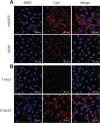Self-assembled nanoparticles based on the c(RGDfk) peptide for the delivery of siRNA targeting the VEGFR2 gene for tumor therapy
- PMID: 25114522
- PMCID: PMC4122582
- DOI: 10.2147/IJN.S63717
Self-assembled nanoparticles based on the c(RGDfk) peptide for the delivery of siRNA targeting the VEGFR2 gene for tumor therapy
Abstract
The clinical application of small interfering RNA (siRNA) has been restricted by their poor intracellular uptake, low serum stability, and inability to target specific cells. During the last several decades, a great deal of effort has been devoted to exploring materials for siRNA delivery. In this study, biodegradable, tumor-targeted, self-assembled peptide nanoparticles consisting of cyclo(Arg-Gly-Asp-d-Phe-Lys)-8-amino-3,6-dioxaoctanoic acid-β-maleimidopropionic acid (hereafter referred to as RPM) were found to be an effective siRNA carrier both in vitro and in vivo. The nanoparticles were characterized based on transmission electron microscopy, circular dichroism spectra, and dynamic light scattering. In vitro analyses showed that the RPM/VEGFR2-siRNA exhibited negligible cytotoxicity and induced effective gene silencing. Delivery of the RPM/VEGFR2 (zebrafish)-siRNA into zebrafish embryos resulted in inhibition of neovascularization. Administration of RPM/VEGFR2 (mouse)-siRNA to tumor-bearing nude mice led to a significant inhibition of tumor growth, a marked reduction of vessels, and a down-regulation of VEGFR2 (messenger RNA and protein) in tumor tissue. Furthermore, the levels of IFN-α, IFN-γ, IL-12, and IL-6 in mouse serum, assayed via enzyme-linked immunosorbent assay, did not indicate any immunogenicity of the RPM/VEGFR2 (mouse)-siRNA in vivo. In conclusion, RPM may provide a safe and effective delivery vector for the clinical application of siRNAs in tumor therapy.
Keywords: gene silencing; self-assembly nanoparticles; siRNA delivery; tumor targeting.
Figures










Similar articles
-
Low-weight polyethylenimine cross-linked 2-hydroxypopyl-β-cyclodextrin and folic acid as an efficient and nontoxic siRNA carrier for gene silencing and tumor inhibition by VEGF siRNA.Int J Nanomedicine. 2013;8:2101-17. doi: 10.2147/IJN.S42440. Epub 2013 Jun 5. Int J Nanomedicine. 2013. PMID: 23766646 Free PMC article.
-
Tumor-targeted in vivo gene silencing via systemic delivery of cRGD-conjugated siRNA.Nucleic Acids Res. 2014 Oct;42(18):11805-17. doi: 10.1093/nar/gku831. Epub 2014 Sep 15. Nucleic Acids Res. 2014. PMID: 25223783 Free PMC article.
-
Modality of tumor endothelial VEGFR2 silencing-mediated improvement in intratumoral distribution of lipid nanoparticles.J Control Release. 2017 Apr 10;251:1-10. doi: 10.1016/j.jconrel.2017.02.010. Epub 2017 Feb 10. J Control Release. 2017. PMID: 28192155
-
Nanoparticles for targeted delivery of therapeutics and small interfering RNAs in hepatocellular carcinoma.World J Gastroenterol. 2015 Nov 14;21(42):12022-41. doi: 10.3748/wjg.v21.i42.12022. World J Gastroenterol. 2015. PMID: 26576089 Free PMC article. Review.
-
Complexing the Pre-assembled Brush-like siRNA with Poly(β-amino ester) for Efficient Gene Silencing.ACS Appl Bio Mater. 2022 May 16;5(5):1857-1867. doi: 10.1021/acsabm.1c01182. Epub 2022 Feb 2. ACS Appl Bio Mater. 2022. PMID: 35107256 Review.
Cited by
-
Establishing an effective gene knockdown system using cultured cells of the model fish medaka (Oryzias latipes).Biol Methods Protoc. 2022 May 17;7(1):bpac011. doi: 10.1093/biomethods/bpac011. eCollection 2022. Biol Methods Protoc. 2022. PMID: 35685404 Free PMC article.
-
A bivalent cyclic RGD-siRNA conjugate enhances the antitumor effect of apatinib via co-inhibiting VEGFR2 in non-small cell lung cancer xenografts.Drug Deliv. 2021 Dec;28(1):1432-1442. doi: 10.1080/10717544.2021.1937381. Drug Deliv. 2021. PMID: 34236267 Free PMC article.
-
Influential Factors and Synergies for Radiation-Gene Therapy on Cancer.Anal Cell Pathol (Amst). 2015;2015:313145. doi: 10.1155/2015/313145. Epub 2015 Dec 9. Anal Cell Pathol (Amst). 2015. PMID: 26783511 Free PMC article. Review.
-
Gelofusine Attenuates Tubulointerstitial Injury Induced by cRGD-Conjugated siRNA by Regulating the TLR3 Signaling Pathway.Mol Ther Nucleic Acids. 2018 Jun 1;11:300-311. doi: 10.1016/j.omtn.2018.03.006. Epub 2018 Mar 14. Mol Ther Nucleic Acids. 2018. PMID: 29858065 Free PMC article.
-
Combination of PEI-Mn0.5Zn0.5Fe2O4 nanoparticles and pHsp 70-HSV-TK/GCV with magnet-induced heating for treatment of hepatoma.Int J Nanomedicine. 2015 Nov 18;10:7129-43. doi: 10.2147/IJN.S92179. eCollection 2015. Int J Nanomedicine. 2015. PMID: 26604760 Free PMC article.
References
-
- Zamore PD, Tuschl T, Sharp PA, Bartel DP. RNAi: double-stranded RNA directs the ATP-dependent cleavage of mRNA at 21 to 23 nucleotide intervals. Cell. 2000;101(1):25–33. - PubMed
-
- Iorns E, Lord CJ, Turner N, Ashworth A. Utilizing RNA interference to enhance cancer drug discovery. Nat Rev Drug Discov. 2007;6:556–568. - PubMed
-
- Aliabadi HM, Landry B, Sun C, Tang T, Uludağ H. Supramolecular assemblies in functional siRNA delivery: where do we stand? Biomaterials. 2012;33:2546–2569. - PubMed
-
- Danhier F, Lecouturier N, Vroman B, et al. Paclitaxel-loaded PEGylated PLGA-based nanoparticles: in vitro and in vivo evaluation. J Control Release. 2009;133:11–17. - PubMed
Publication types
MeSH terms
Substances
LinkOut - more resources
Full Text Sources
Other Literature Sources
Molecular Biology Databases

